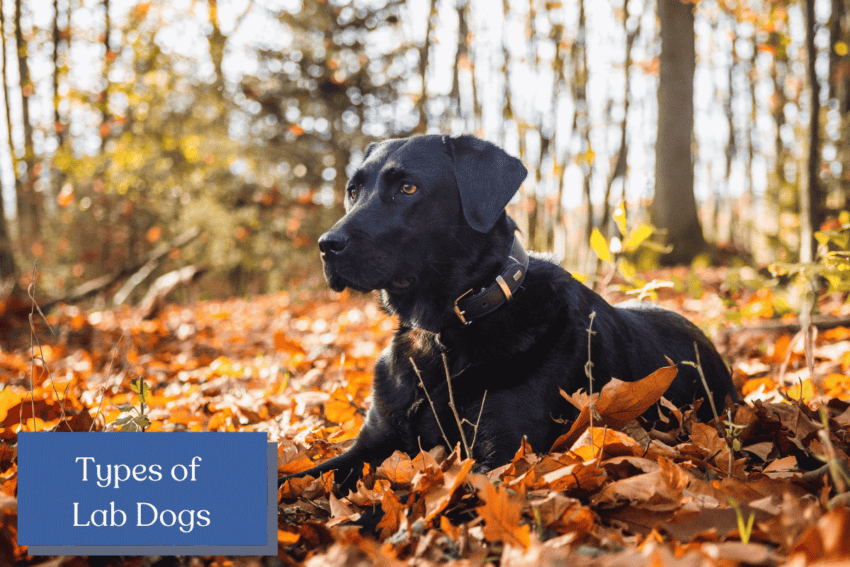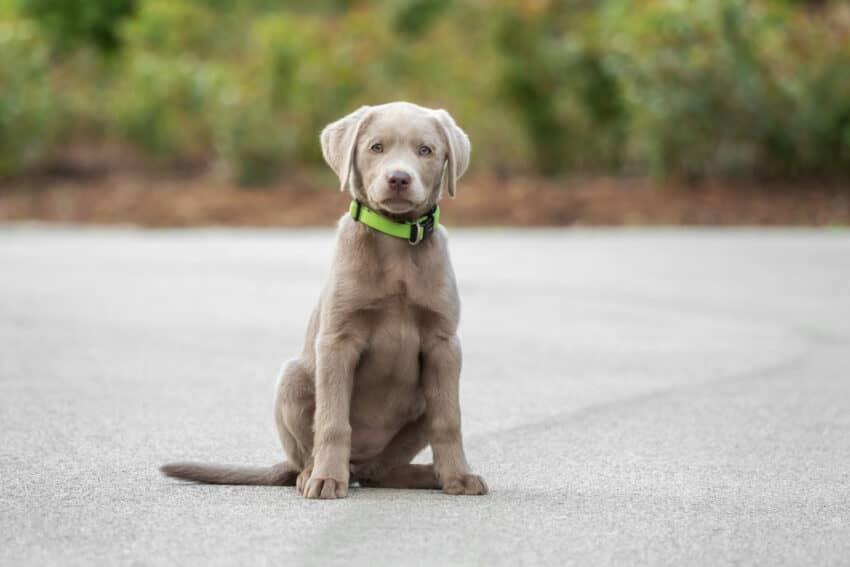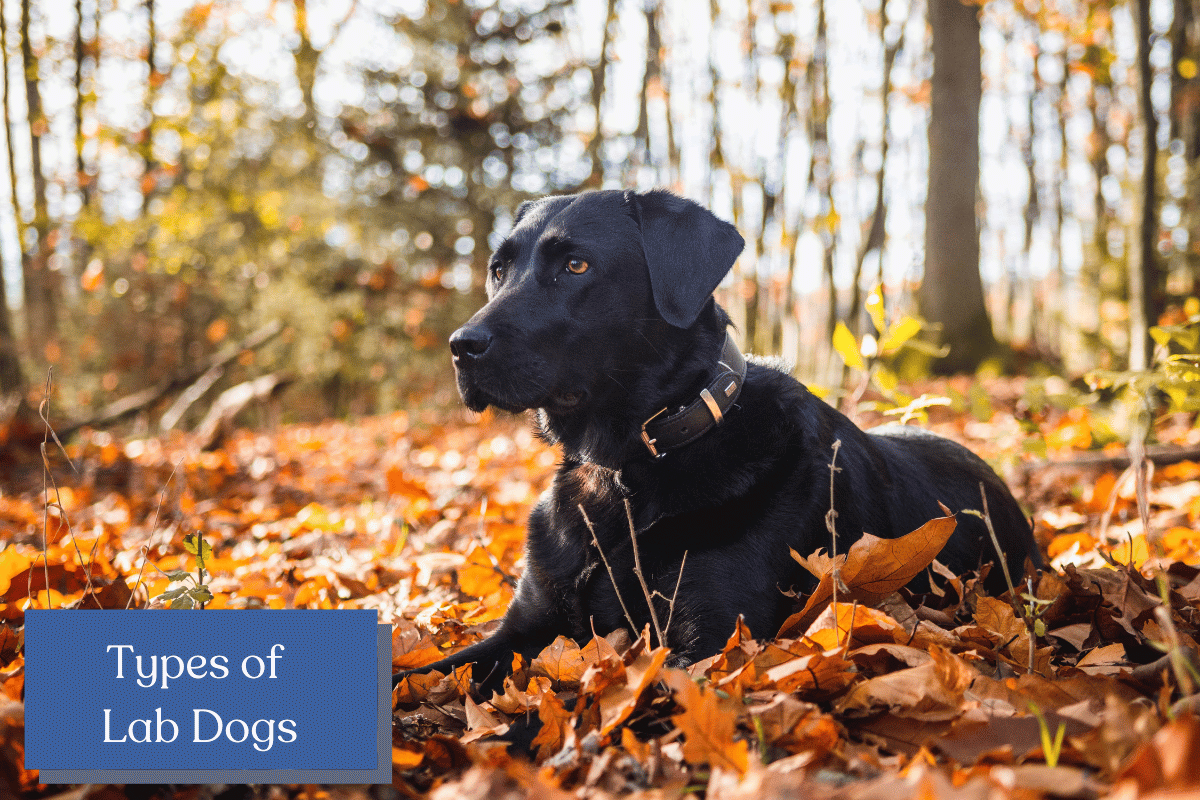Every parent seems to have their eye on lab dogs for their child’s first pet. It’s a smart choice, considering their reputation and well-established foothold in our society. Few animals have adapted better to the domestic lifestyle than labradors.
But I’ve noticed people don’t seem to have a handle on all the lab dog types. So today, I’ll run through all of them and color variations to ensure you can become an expert. But first, let’s have a quick overview of what a lab is to get everyone on the same page!

What is a Lab?
Lab dogs refer to a favorite breed within our dog community, Labrador Retrievers. Honestly, I don’t think there’s a breed with a better reputation besides its relative (Golden Retriever). These intelligent, fun-loving dogs are a marvelous addition to almost any home.
Labrador Retrievers were bred for their sunny deposition as a companion. But it wasn’t the only trait that made them a wanted commodity. These dogs are also known for being exceptional work dogs, especially on hunting trips.
During these hunting trips, humans would use labs to retrieve fallen prey. It’s a useful way to prevent hunters from having to find their kills. Plus, it saves time, considering dogs are much better trackers.
However, their purpose as working dogs isn’t as valued these days. But their loyal companionship has become even more popular among dog owners. You’ll also find them being assistance dogs, search/rescue dogs, and show competitors.
Different Types of Lab Dogs
I’d imagine some people reading this article have assumed there are many types of Labrador Retrievers. It’d make sense, considering their popularity and attractive traits. But there are only two primary types: American Labrador Retrievers and English Labrador Retrievers.

1. American Labrador Retriever (Working Dogs)
American Labrador Retrievers get their name from being a popular breed in the US. However, they didn’t originate from the states like it would seem to suggest. They were developed and come from Britain, like all other types of lab dogs.
So what makes them different from English Labrador Retrievers? Well, it comes down to what their purpose as American Labrador Retrievers is the working type. If a lab is being used on a farm, there’s a high likelihood it’s this type.
Given this information, it’s no surprise that their physical profile is more impressive. These dogs are much more muscular and athletic than an English Labrador Retriever. It makes them more adaptable to work and less vulnerable to wear/tear.
Some other notable physical traits include a longer snot and extremities. These body parts are much more relied upon by working dogs like American Labrador Retrievers. Again, it’s a perfect situation to ensure a workload doesn’t take such a massive toll on their body.
Lastly, these labs require more attention from their owners than English types. It comes from their excessive energy levels and hunting instincts that need to be accounted for by any prospective owners. You’ll need to design a schedule to give them stimulation, training, and exercise throughout the day.
It could be from daily walks, hikes, jobs, or swimming. Honestly, it doesn’t matter what the activity is; it just needs to zap any unused energy throughout the day. I’d wager two or three hours of daily exercise should be enough.

2. English Labrador Retriever (Show Dogs)
English Labrador Retrievers are considered a much more luxurious breed. It’s common to see them competing in shows with a defined genetic history built around appearance traits. So over time, these dogs have gone further and further around from their hunting roots.
As a result, their physical profile doesn’t offer the same athleticism seen in American types. It’s more stockier with a larger overall build. Other notable physical traits include a smaller head, shorter snout, and wider legs.
These qualities result in a more appealing and striking look than their American relatives. But since English Labrador Retrievers aren’t bred for work, their fitness is a concern. Obesity is often troubling for these labs, so owners must be careful.
But people who do get an English Labrador Retriever usually love them. These dogs are delights to have around with a calm, docile, and fun personality. Any family would benefit greatly from having one in their homes.
I’d only advise getting them socialized and trained ASAP. Honestly, English Labrador Retrievers can become a bit of a handful if given to an owner who isn’t attentive. So at an early age, getting them used to commands and understanding your home’s hierarchy is a wise move.

What Are the Primary Labrador Retriever Coat Colors?
You now know Labrador Retrievers have two distinct types. However, these types aren’t the only way these dogs are classified. Owners can also expect them to be separated by their coats with primary and secondary colors.
So it’d be wise to discuss all the primary and secondary colors. It’ll provide a better idea of what a prospective owner can expect when at these dogs. Let us start with the three primary colors: black, chocolate, and yellow.

1. Black Labrador Retriever
Black Labrador Retriever have been the most common coat color for a long time. It makes sense, considering how easily black coloring can blend into the surroundings. Therefore, it’d be helpful to sneak up on prey during hunting trips.
So early breeders strategized to increase black coloring among these retrievers. The simplest way to do this method would be to kill all puppies with other coat colors. It’s a practice that stood for centuries until the 20th century.
Thankfully, the other colors have seen an increase in popularity. But black remains dominant, with about half of these dogs having it color their coats. Overall, anyone looking for a hunting Labrador Retriever would do best with this color.

2. Chocolate Labrador Retriever
Most people consider Chocolate Labrador Retrievers to be the most lively. Of course, there isn’t research backing this belief, but it’s a widely accepted notion. They often seem to have more energy than the other two primary colors.
Chocolate Labs also are the scarce primary coat color. As you can imagine, it makes them a wanted commodity within the dog community. I didn’t even mention this coat coloration’s beauty and elegance, either.
Seeing a Chocolate Labrador isn’t something a dog owner will forget. These dogs are absolutely adorable and deserve all the admiration that people give them. It’s on my bucket list to adopt one, but nobody brings them into shelters, and I don’t trust breeders.
The only downside with this coloration is they’re more prone to health problems. On average, black and yellow variations live longer, which should factor into anyone’s decision. So it’s something to think about when adopting or buying your new Labrador.

3. Yellow Labrador Retriever
The last primary coloration would be Yellow Labrador Retrievers. You could make a solid argument for them being the most well-known coat color. After all, this variation has been all over TV and movies for decades and decades.
Their yellow coloration seems to love the camera, as they light up the screen every time they pop on it. It certainly has become a classic look for a reason. But their famous use in movies isn’t what makes Yellow Labs unique.
Instead, I’d put this title to their work as service dogs, which they’re more involved in than black or chocolate labs. You often see these labs being guide dogs for the blind and other disabilities. Their friendliness just lights up anywhere they adventure.
I’d imagine these labs excel in these roles because of their eagerness to learn and train. It makes them ideal fits for service jobs and other similar positions. It’s also why I’d consider them an excellent option for a first-time owner.

What Are The Labrador Retriever Secondary Colors?
Secondary colors are known variations but aren’t accepted by organizations like the American Kennel Club. In the case of Labrador Retrievers, three alternatives are more notable and stand out more than the rest:
1. Silver Labrador
Silver is potentially the rarest coat color among primary and secondary variations. Due to this, it has become much more sought-after within the dog community. It also offers a striking light gray/bluish tint, which shines brightly under the sun and becomes almost silver.
However, owners must be careful about this coloration because it’s known for being more prone to health issues. I wouldn’t consider it worth the risk and vet bills. You’d be better off sticking with a primary color without known associated health conditions.
There’s also the thought of silver labs not being purebred Labrador Retrievers. It’s a hotly debate topic among breeders and dog owners, which doesn’t have an official answer. So be weary of people jacking up prices based on a silver coloration.

2. Fox Red Labrador:
Clifford is all I think about when discussing Fox Red Labrador Retrievers, especially given their friendly dispositions. He was my favorite growing up, and I’ve since grown an attachment to this coloration for this reason.
But in any case, this variation doesn’t get an official stamp because their genetics match yellow labs. The only difference is a brown/yellow tint within their coats.

3. White Labrador
White is another secondary coloration with matching genetics to yellow labs. White Labradors don’t have any health issues or personality traits unique to them. Instead, they’re simply a paler version of the well-established yellow lab.
So it’d be a mistake to call them Albino Labrador Retrievers; they aren’t white but rather an incredibly pale yellowing coloration. It’s a distinction that can be confusing when adopting or buying these dogs.
Conclusion
So what are the different types of lab dogs? The classification starts by breaking them into two primary types: American Labrador Retrievers (working dogs) and English Labrador Retrievers(show dogs). The number of types becomes even more numerous when factoring in coat colors (black, chocolate, yellow, silver, fox red, and white).
Nevertheless, one thing should be clear about Labrador Retrievers. There’s a perfect combination for anyone who wants an active but friendly family pet. It’s why this breed remains the most popular in the entire world.
Leave me a comment below if you have any experience with lab dogs or have questions. I’d love to hear and discuss more about this wonderful dog breed. Thanks for reading!


